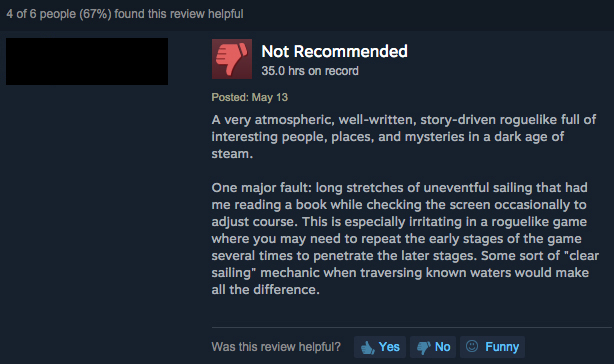
Featured Blog | This community-written post highlights the best of what the game industry has to offer. Read more like it on the Game Developer Blogs or learn how to Submit Your Own Blog Post
A Call for Responsible Steam Reviews in 2016
Negative Steam user reviews can largely impact an indie game's sales. But if written constructively, they can also elevate the quality of that game. By sharing data and my thoughts, I hope to help users understand their impact and act responsibly.


This article was originally posted on indiegamegirl.com.
As a fan of indie games, I find the lack of thought in many negative Steam user reviews disturbing. As a marketing consultant who has helped numerous indies launch their titles on Steam and seen the impact these reviews have on sales, I find this apathy appalling. Perhaps it’s the desire to be the “class clown,” or a love of shock value that motivates Steam users to leave negative reviews like “It sucks,” “Waste of time and money” or “Your mother is an alcoholic.” But as someone who is well versed in the effect of these reviews, I have to chalk it up to ignorance so I continue believing people are inherently good.
When I say that negative user reviews impact sales, it’s an understatement. Through my analysis of my clients’ Steam sales data and how it’s affected by variables like negative user reviews, external promotion, Steam featuring, etc., negative user reviews are one of, if not THE, major negative influencers on sales. To illustrate how much of an impact these reviews can have, consider one of the more extreme cases I’ve worked on: When the game received its first negative reviews after launch, my client’s conversion rate (CVR) from visits to its Steam game page to purchase of its game dropped by 68 percent. This drop occurred while all other variables remained largely constant. And while this example skews toward the extreme, statistically significant drops in CVR after receiving negative customer reviews is a correlation I’ve observed across the board on multiple platforms.
This correlation can also be observed in the context of a game’s overall user review (e.g., Overwhelming Positive, Very Positive, Mixed, etc.). When examining the data from two past client games—one with a “Very Positive” and the other with a “Mixed” overall user review—the game with the Very Positive overall user review had a 73 percent higher CVR during the two-week period after launch than the game with the Mixed overall user review. There are other variables at play, but the correlation between sales performance and overall user review is significant.
Purely Negative vs. Constructively Negative Reviews
Before anyone assumes that I’m advocating for Steam users to stop leaving negative reviews altogether in favor of helping developers’ sales, I want to make it clear that this is NOT the case. User reviews, whether positive or negative, are a critical part of buyer and developer education…which I’m 100 percent for. However, there is a difference between purely negative and constructively negative user reviews. The latter is what I’m advocating.
Purely Negative Reviews
Above is an example of what I'd call a “purely negative Steam user review.” In this review, the Steam user gives neither prospective buyers nor developers specific or constructive feedback to inform buying decisions or development updates. Instead, he gives the impression that the game is just bad. But, because this reviewer gave the game a “thumbs down,” Steam counts it toward the game’s overall user review and it will be displayed on the game’s page. As a result, it could negatively affect the game’s sales.
Perhaps even more harmful than its possible effect on sales though, is that this review robs the developer of the opportunity to act responsibly and take action quickly. Without reaching out to this Steam user and hoping he responds with specifics and fast, the developer has no way of knowing why its game is disappointing and therefore cannot even attempt to turn this customer’s experience from negative to positive. In turn, by not providing constructive feedback, this Steam user is lowering his chances to see the improvements he wants made to the game and thus robs himself of getting a better value for the money he spent.
Constructively Negative Reviews
Here is a screenshot of a “constructively negative Steam user review” taken from the same indie game as above. In this review, the Steam user does three things very well to make his review constructive. First, the user identifies what he takes issue with in the game. Second, he explains why he takes issue. Third, he offers a suggestion for how this issue could be improved or even fixed.
By doing these three things, this Steam user is giving the game’s developer actionable feedback. In addition, he is providing other users with information that is specific enough where an informed buying decision can be made. If the user said something like “the sailing aspect is boring,” other users may dismiss the game as boring in general and not make a purchase. However, because this user specifically states why he believes sailing is boring, other users have more information to determine whether they too would find sailing boring for this reason, or whether this reasoning should even factor in their buying decision.
The Teams Behind Indie Games
Before I move onto suggestions for being a responsible Steam user reviewer, I want to take a moment to talk about the teams behind these indie games. While I can’t speak for all indie games published to Steam, I can speak to those I’ve worked on. The teams behind these games are incredibly talented, passionate, dedicated and ethical. Most notably, however, they are small. The majority of the teams I’ve worked with are comprised of five or less people, all of who have made enormous sacrifices—financial and otherwise—to do what they love. And because of the sacrifices they made, these teams take enormous pride in their work and care deeply about what their customers think. This is not only because they want to make great games, it’s also because the revenue they make from the games they publish often dictates whether they can continue developing their own games at all. Getting positive reviews is a big part of earning revenue. The indie teams I’ve worked with recognize this and are highly motivated to create great games at launch and to continue improving them based on customer feedback. Note: This is not meant to persuade you from leaving negative reviews out of charity, but rather promote the merits of being constructive if you plan on leaving a negative review because developers are personally invested in customer satisfaction and eager to improve their games based on what you think.
How to become a responsible Steam user reviewer?
Understand the impact your review could have and take it seriously.
Before writing a negative review, remind yourself of the kind of the impact it may have on that indie game’s sales and the team who’s counting on those sales. Use your knowledge to take your task seriously.If you’re going to write a negative review, make it constructive.
Sharing your experience with a game is a great thing, but if you’re going to write a negative review, make it constructive. Constructive reviews allow developers to improve their products for the benefit of you and the community, as well as help other Steam users make informed buying decisions.Be open to adjusting your review if the developer addresses your issues.
The goal of a constructively negative review is to help Steam users make informed buying decisions and give developers feedback to improve their games. If a developer addresses your issues based on the feedback you gave in your review, it means your review was effective. It also means the developer is acting in a responsible way that’s worthy of support. Take some time to reward this effort by giving the game another shot and revising your review if the issues you raised were remedied.
Final Thoughts
My hope from sharing the above data and thoughts is that I’m able to paint a very clear picture of how negative Steam user reviews impact indie game sales and the teams behind these games. I hope Steam users who are considering writing a negative review of an indie game do so responsibly and respectfully. If you played an indie game and didn’t enjoy it, fine, but understand that your negative review could impact someone’s livelihood and career. In your negative reviews, be constructive. Give developers the chance to improve their product by (1) clearly identifying what you disliked about the game, (2) why you disliked those aspects and (3) suggestions for improvement. Reviews with these three components will also provide other Steam users specific enough information to make informed buying decisions.
As we move into 2016, my wish is that enough Steam users adopt this philosophy to not only help developers improve their games on an individual basis, but elevate the quality of indie games on Steam as a whole. And, for those of you who are on the fence with this philosophy and need better reasons to stop writing purely negative reviews, I’ll simply refer you to Wheaton’s Law.
Read more about:
Featured BlogsAbout the Author(s)
You May Also Like







.jpeg?width=700&auto=webp&quality=80&disable=upscale)








